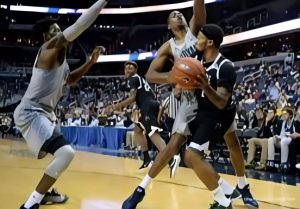Basketball defense encompasses the strategies, positioning, and techniques used to prevent the opposing team from scoring. Effective defense requires agility, strong footwork, and a solid grasp of fundamentals. Defenders work together to contest shots, box out for rebounds, and avoid unnecessary fouls. The goal is to force turnovers, creating fast-break opportunities for quick scoring. A strong defense disrupts offensive plays, limiting open shots and easy baskets. Coaches often assign their top defender to guard the opposing point guard, who is typically the team’s primary playmaker and scorer. A well-executed defensive system enhances a team’s overall performance, turning defensive stops into offensive advantages.
5 Types of Defenses
1. Man-to-Man Defense

Man-to-man defense is a strategy where each defender is assigned a specific offensive player to guard throughout the game. Typically, players match up against their corresponding positions—for example, a small forward defends the opposing small forward. However, defensive assignments can change based on matchups, weaknesses, or strategic adjustments.
This defense allows players to force ball handlers toward the sidelines and baseline, creating trapping opportunities. It also enhances rebounding by simplifying box-outs in the paint. Man-to-man defense is widely used in youth and high school basketball as it reinforces fundamental skills, improves individual defensive abilities, and fosters overall player development.
2. Zone Defense

Zone defense is a strategy where each defender is responsible for guarding a specific area of the court rather than a particular player. A defender engages an offensive player when they enter their designated zone but does not follow them outside of it, unlike in man-to-man defense.
There are various zone schemes, classified based on player alignment. The first number in a zone defense represents the players positioned near the top of the key, while the last number indicates those stationed near the baseline. Zone defense is effective in limiting dribble penetration, protecting the paint, and forcing opponents into difficult perimeter shots.
3. Combination Defense
A combination defense, or junk defense, blends man-to-man and zone principles to disrupt the opposing offense. While not a primary defensive strategy, teams use it situationally to shift momentum or neutralize a dominant scorer.
These defenses can be risky due to potential coverage breakdowns but can be effective when facing a stronger opponent. Common combination defenses include:
- Match-up Zone: A hybrid where defenders guard areas but match up when opponents enter their zones.
- Box-and-One: Four players form a zone, while one guards a key player man-to-man.
- Triangle-and-Two: Three players play zone, while two defend specific scorers man-to-man.
- Diamond-and-One: A diamond-shaped zone with one player in man-to-man coverage.
4. Full-Court Press Defense

A full-court press is an aggressive defensive strategy where defenders apply pressure across the entire court, starting from the inbound pass. Teams can execute this press using either man-to-man or zone schemes.
This defense is often used late in games when a team needs to force turnovers, as the relentless pressure increases the likelihood of steals and deflections. Additionally, it can exhaust opponents, making it effective against teams with weak ball handlers or limited bench depth. The full-court press forces quick decisions and rushed plays, disrupting the offensive rhythm and creating fast-break scoring opportunities.
5. Half-Court Press Defense
A half-court press is a defensive strategy where defenders apply pressure as soon as the offense crosses the half-court line. Teams can execute this press using either man-to-man or zone schemes.
Unlike the full-court press, which is typically used in short bursts, the half-court press can be sustained throughout an entire game. Its primary objectives are to force turnovers, fatigue the offense, and disrupt the opponent’s rhythm. This strategy carries less risk than a full-court press since defenders are already positioned in the frontcourt, reducing the chances of fast-break opportunities for the opposing team.
